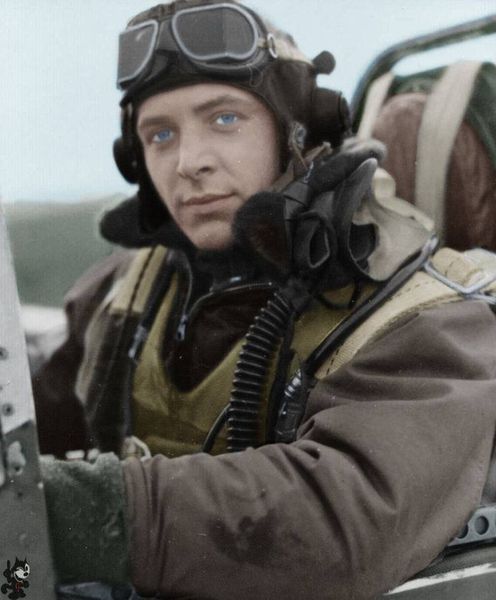Top Ace in the 357th Fighter group. Fought in WW2, Korea, Vietnam.
Born on March 12, 1923 and was from Nebraska
From the National Museum of the 8th Air Force:LEONARD "KIT" CARSON - TOP 357TH FG ACE
Leonard 'Kit' Carson with 18.5 victories was the top ace of the 357th Fighter Group. His first victory was on April 8th 1944. He scored all his 18.5 victories flying five mustangs all named "Nooky Booky".
Kit Carson went onto to run the 357th's combat training school or Clobber College. Captain Leonard K. Kit Carson, on the 38th mission of his second tour and having nine previous credits, became the second 357th pilot to become an ace in a day. He was squadron commander between 8 April 1945–1 November 1945.
Carson was on the verge of heading for the Pacific with a P-39 outfit, but instead joined the 357th. His first victory was on April 8, 1944. His chosen technique for success was to bore in close to his victim, rather than rely on deflection shooting. He chalked up the bulk of his score during the final six months of the war, flying "Nooky Booky IV". He ran 'Clobber College' the 357th's combat school, for a time, passing on his skills.
When training, he emphasized the challenges of flying seven-hour missions in the harsh weather of Northwestern Europe. He stressed the importance of the "two-ship" element, and the defensive strengths of the P-51. "Do anything you can to break his line of sight on you. Once you've done that, he can't lay a glove on you." He insisted that the new pilots master instrument flying, a necessity in the rain, snow, ice, and poor visibility of the ETO. "Anyone who has a casual attitude toward flying in this climate is going to wind up wearing an 8,000 pound coffin at the bottom of the North Sea." He noted that they should all become intimately familiar with the east coast of England, as the biggest aid in zeroing in on home base.
For gunnery, he encouraged the new pilots to close in from behind, noting the difficulties of deflection shooting. "Get dead astern and drive in to 200 yards or less, right down to 50 yards and fire a couple of one-second bursts." He told the pilots to think about six and seven hour missions, and to dress as if they "were going to have to walk out of Germany."
Following the war he remained with the US Air Force, retiring as Colonel in 1968 to work in the aerospace industry. He published a book entitled "Pursue and Destroy" in 1978.
This hero passed away in 1994.

PRIVATE CITIZENS SUPPORTING AMERICA'S HERITAGE
American
War Memorials Overseas, Inc.
War Memorials Overseas, Inc.
Carson Leonard Kyle “Kit”
Name:
Leonard Kyle “Kit” Carson
Rank:
Captain
Serial Number:
Unit:
357th Fighter Group
Date of Death:
1994-03-08
State:
Nebraska
Cemetery:
Chester Cemetery, Chester, Plumas County, California
Plot:
Row:
Grave:
Decoration:
Comments:
